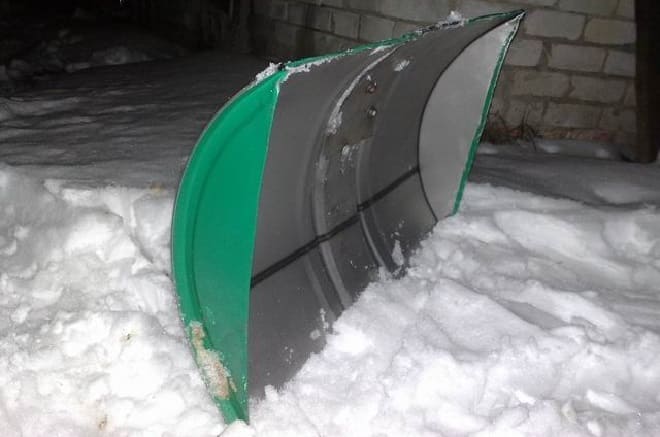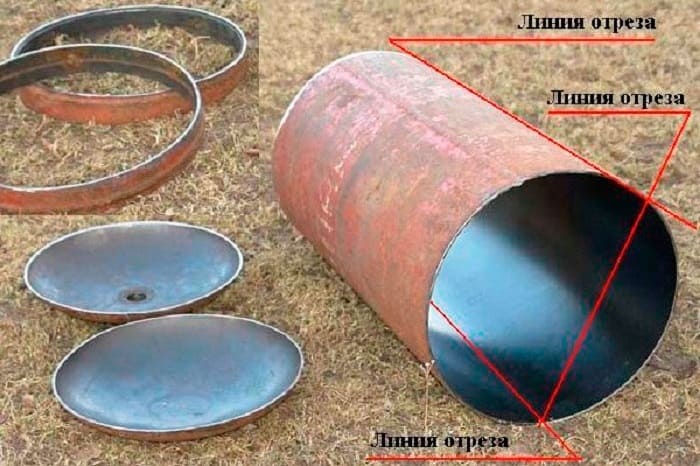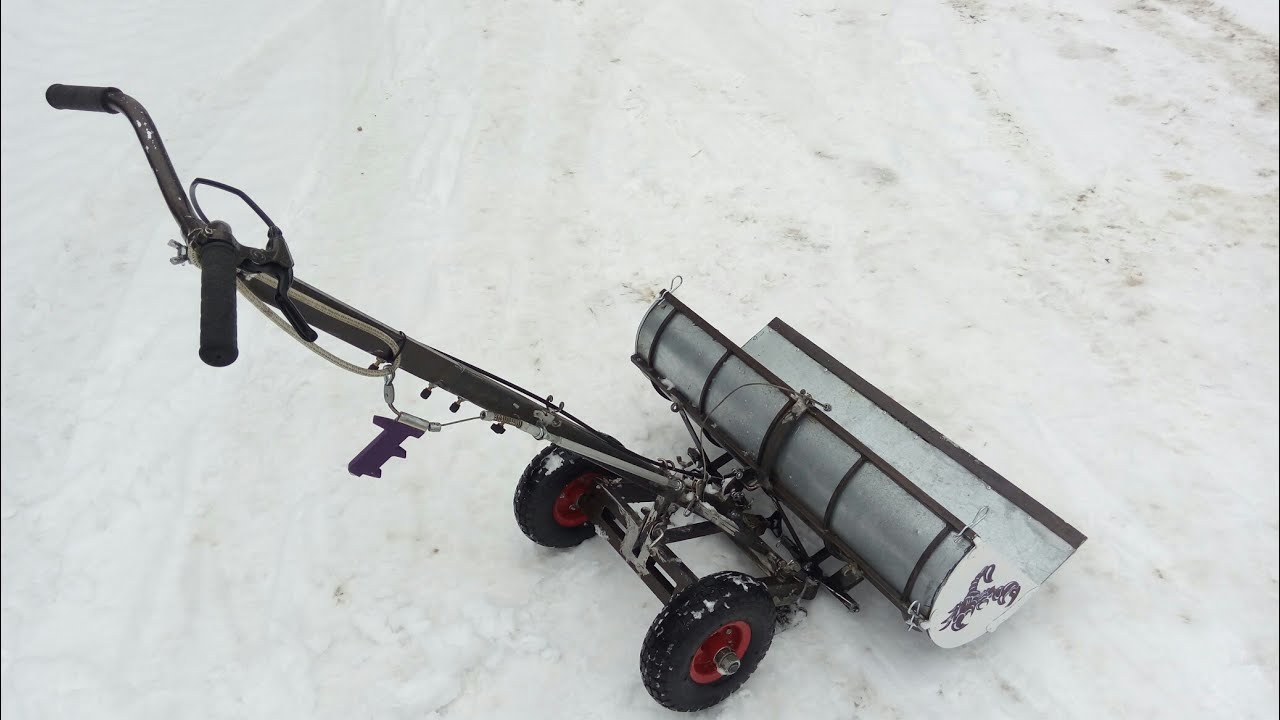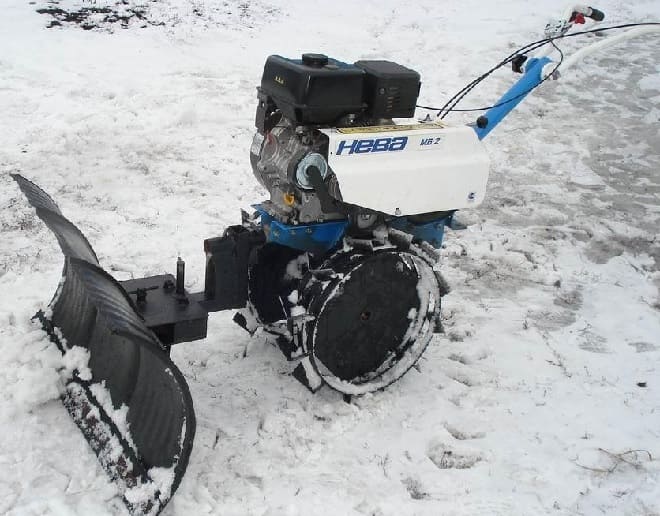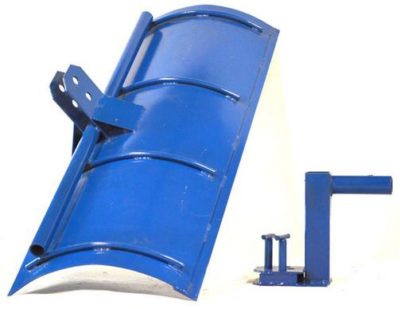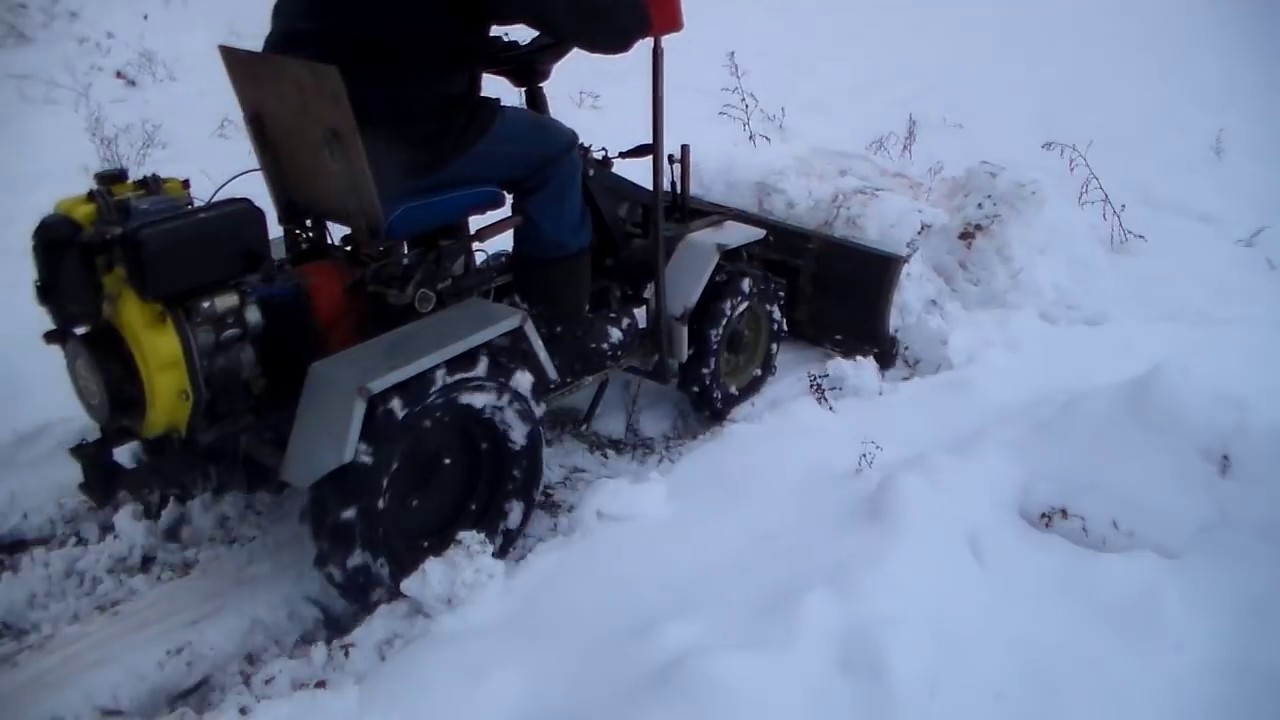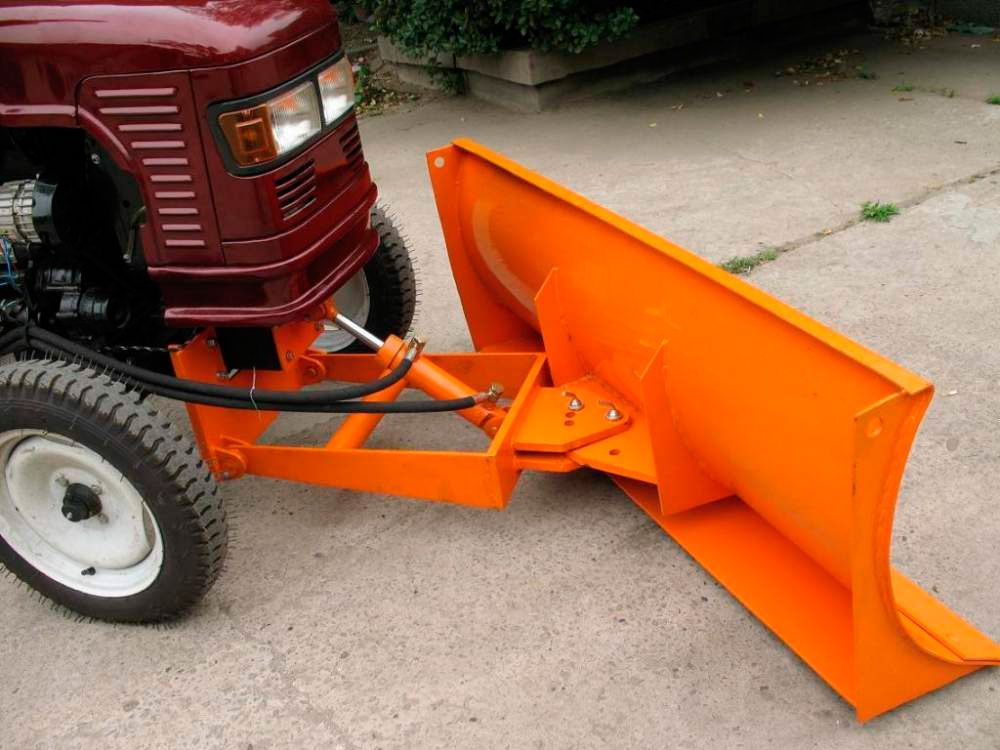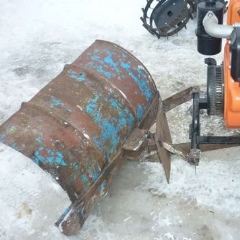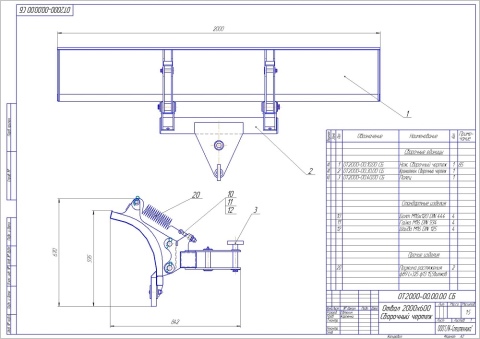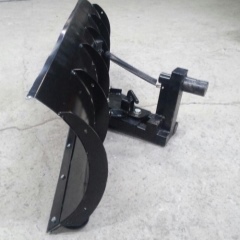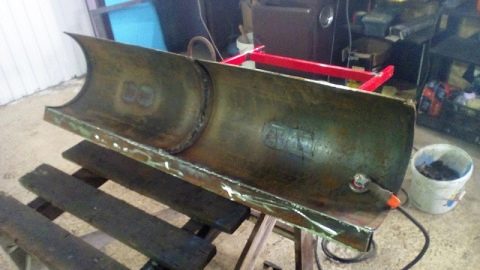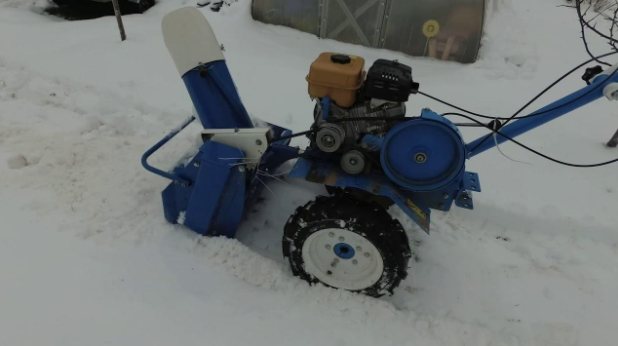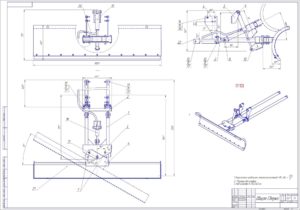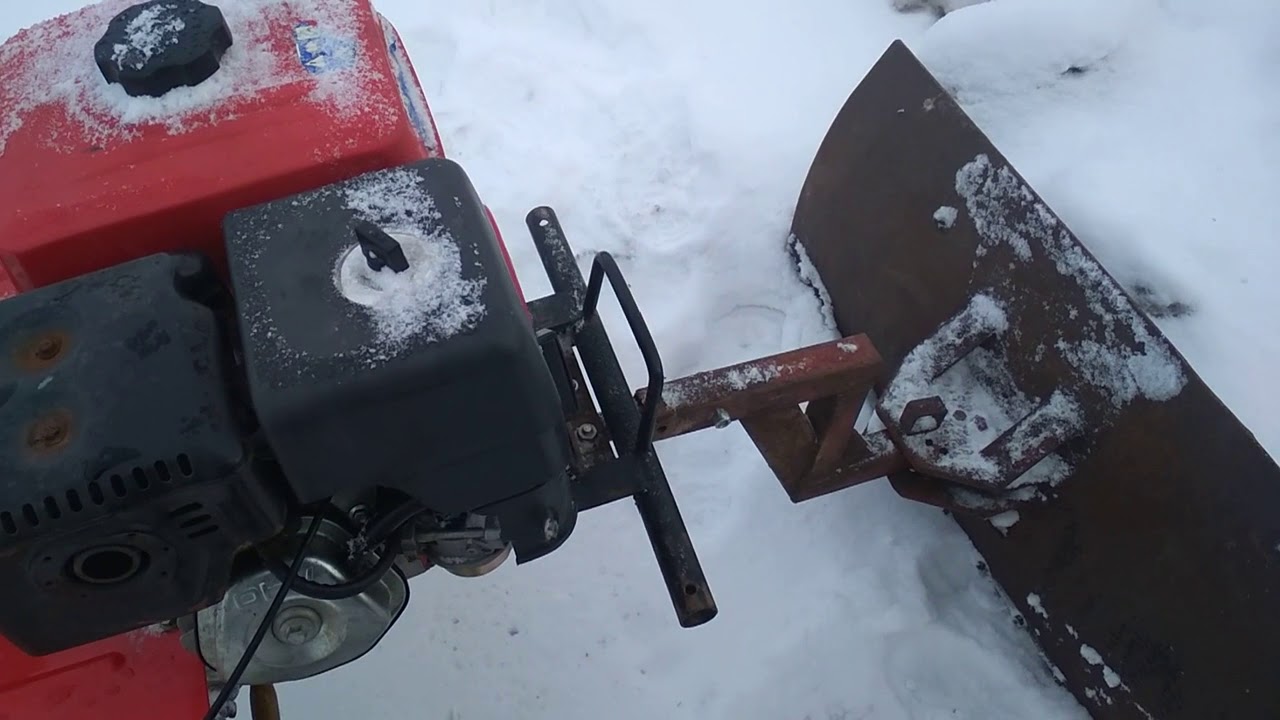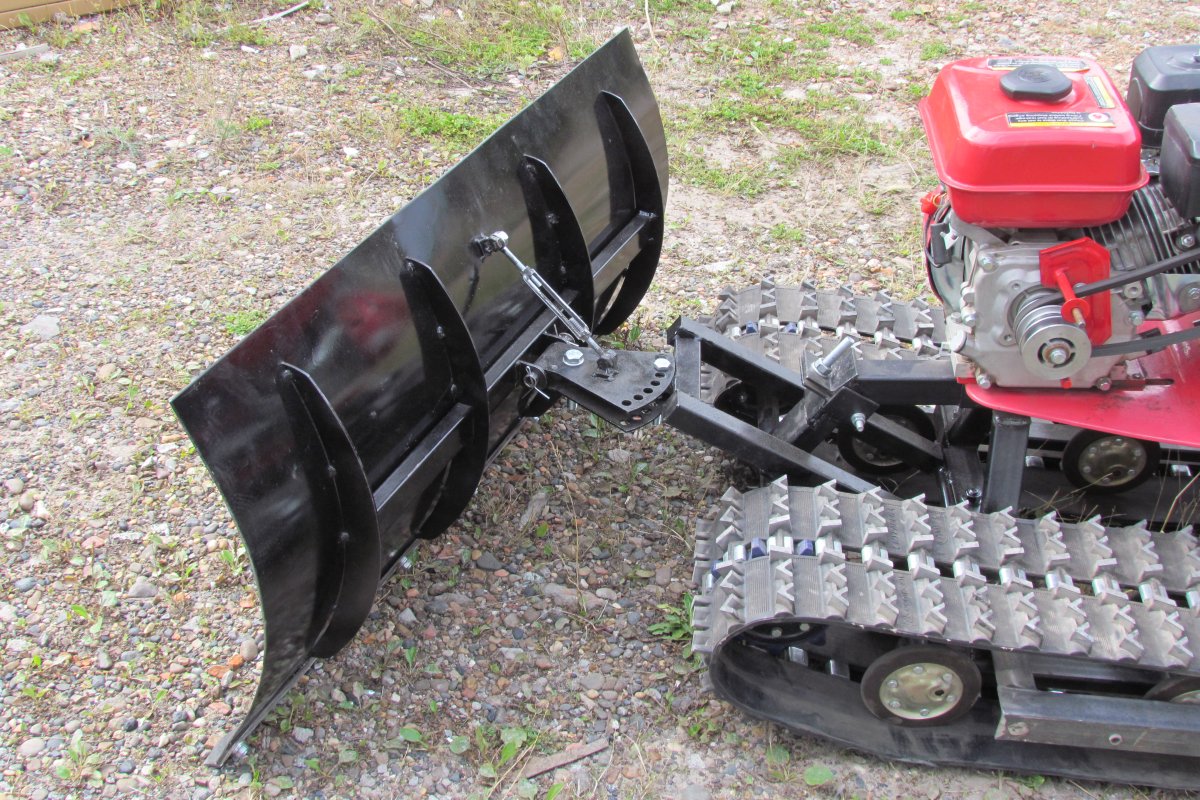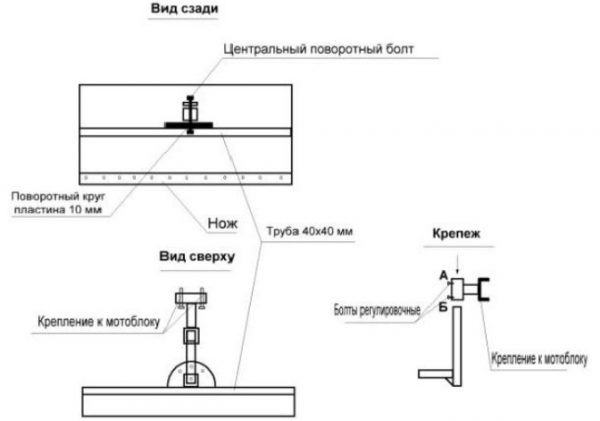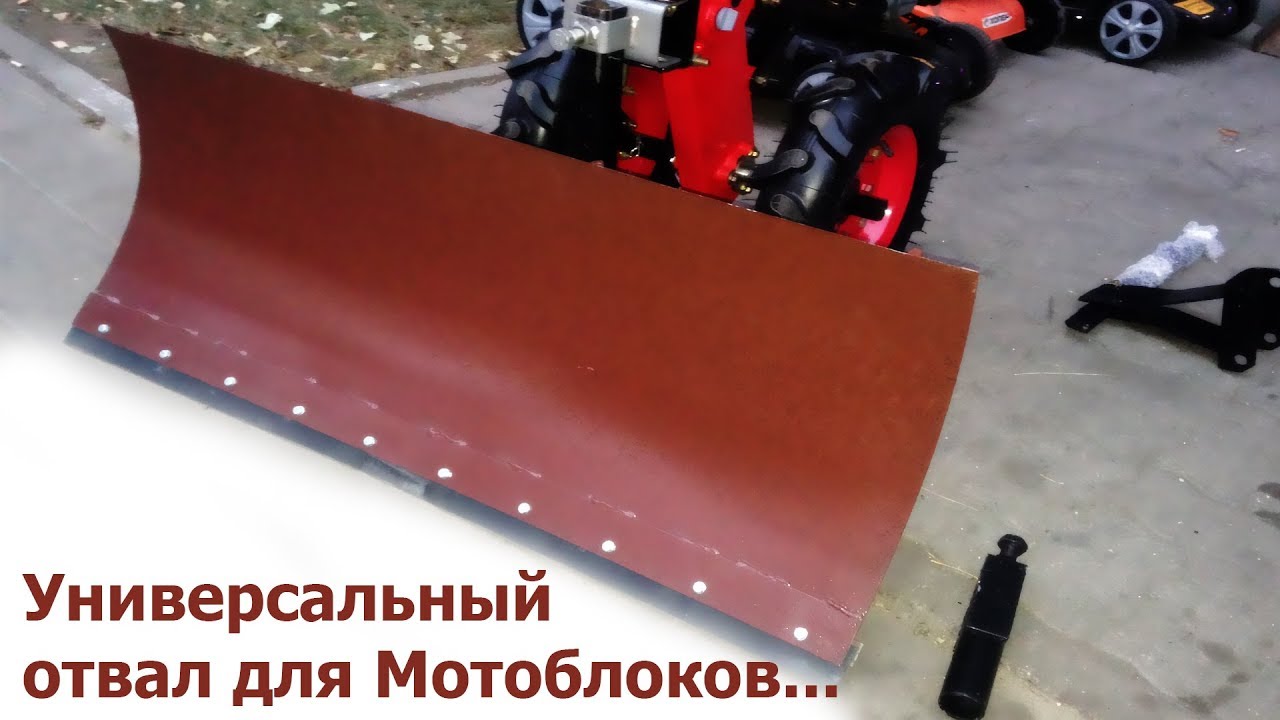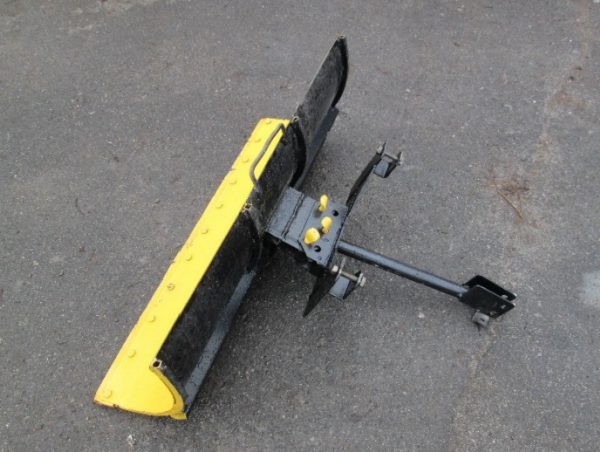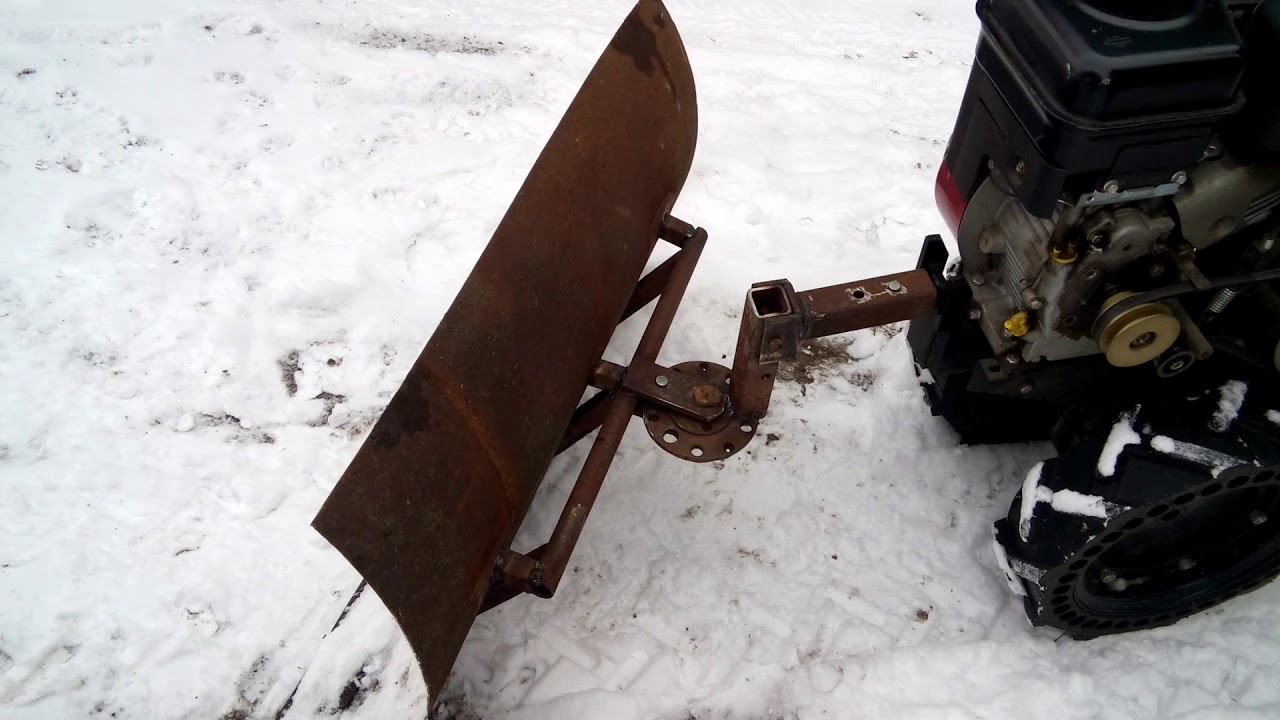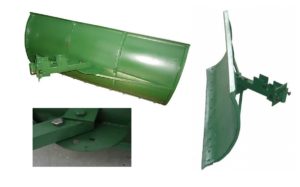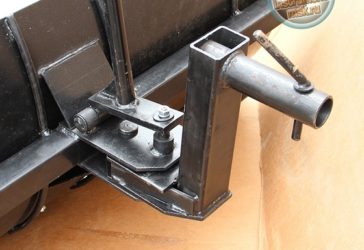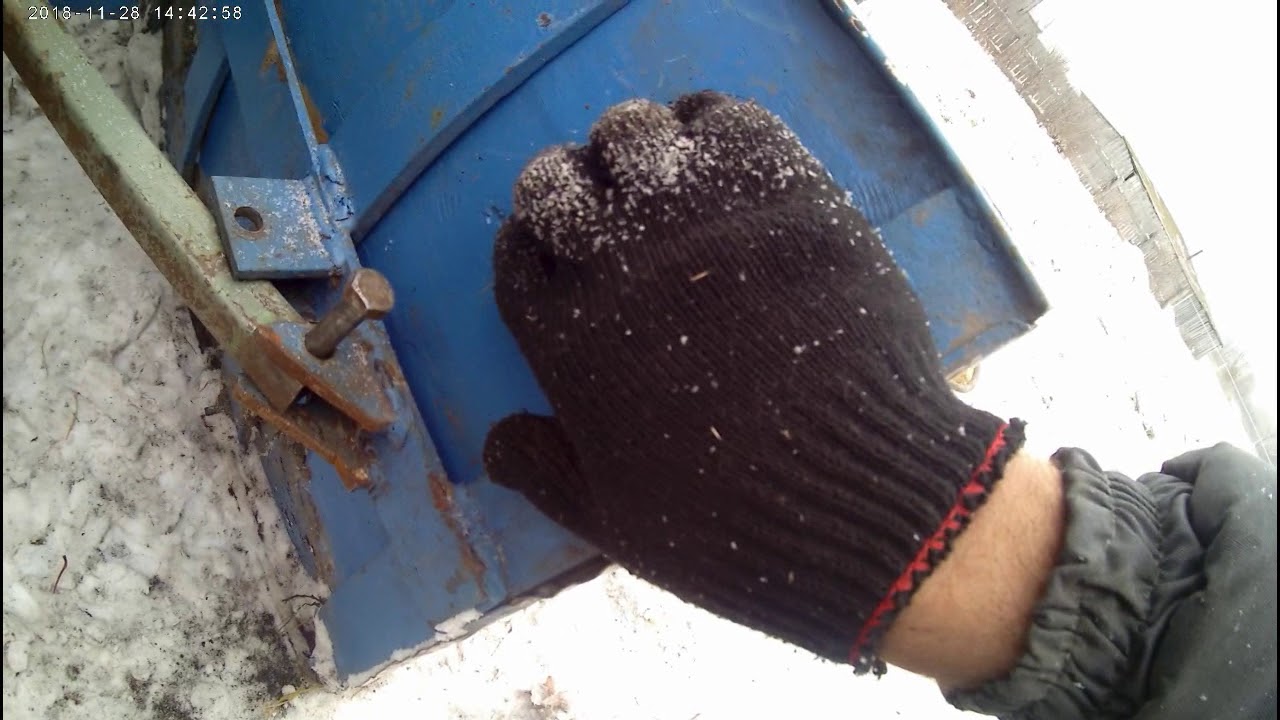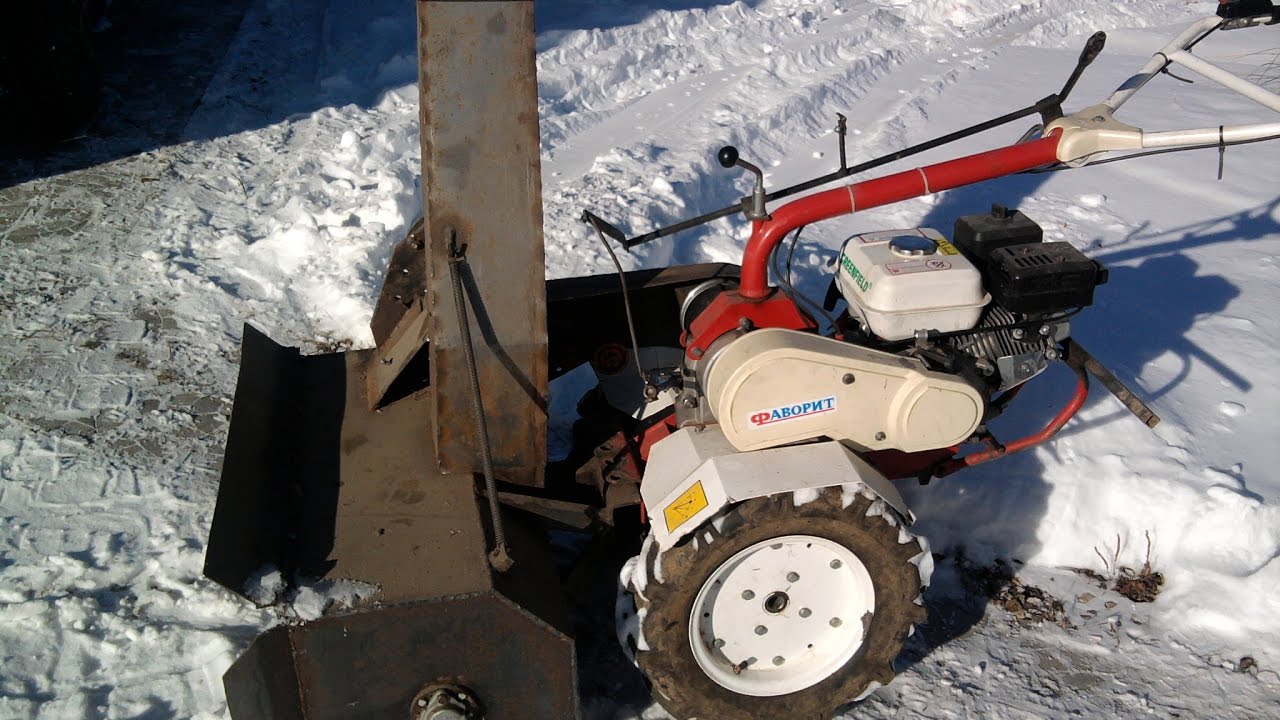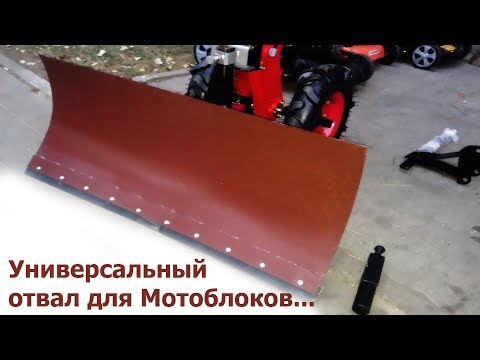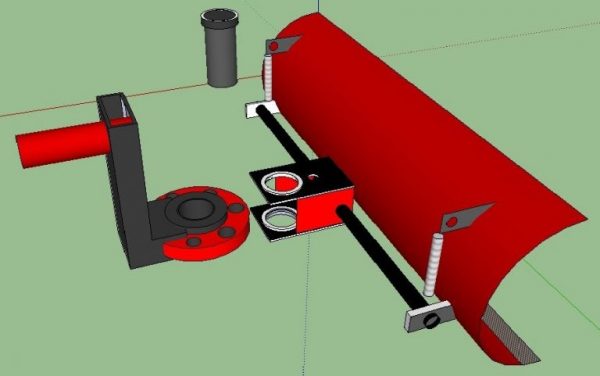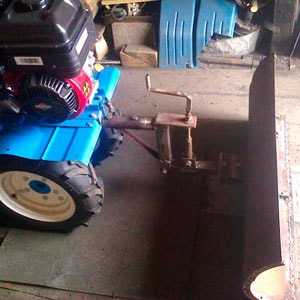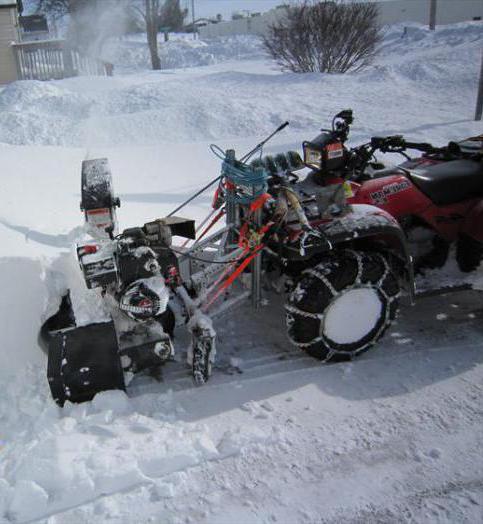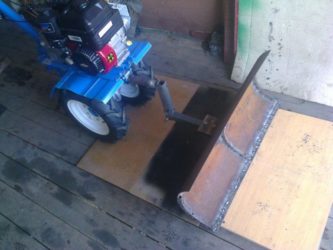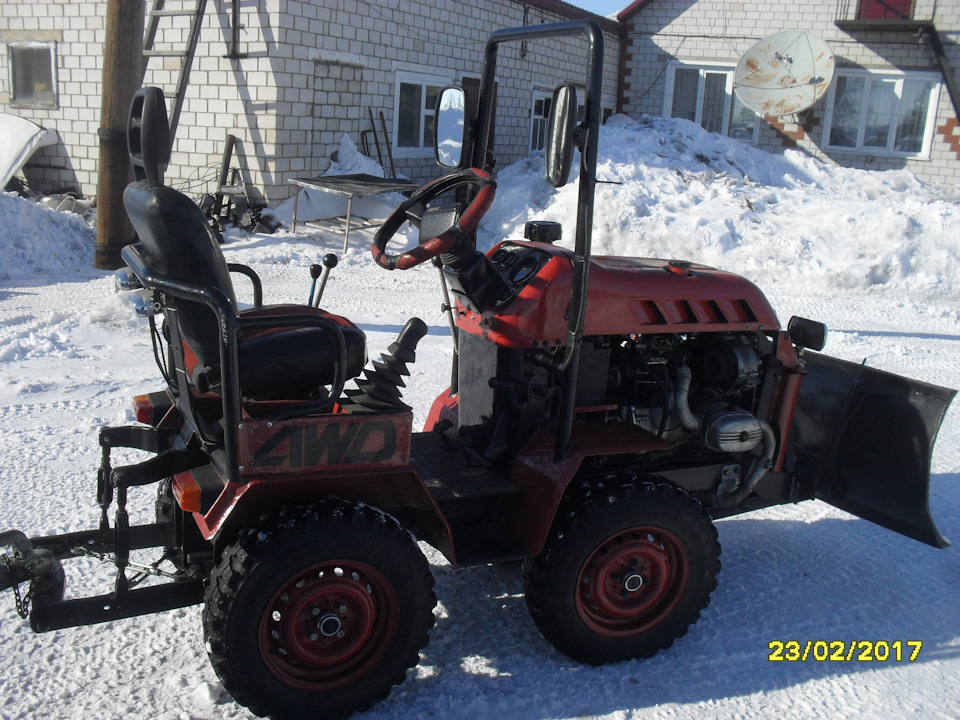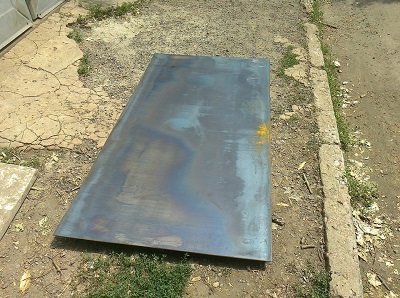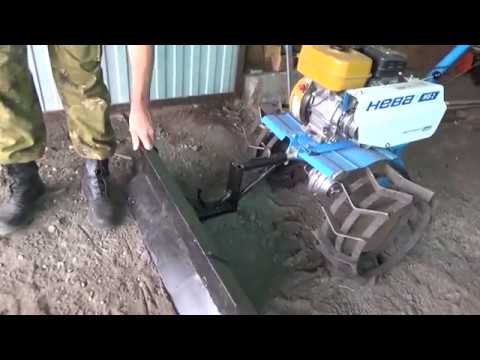Design features
First, let's decide on the design itself. The motoblock blade shovel is a curved working surface, which consists of the following elements:
- rigid frame;
- stiffeners;
- curved steel sheet 2 mm thick .;
- heels (2 pcs.);
- knives (metal and rubber).
A metal knife is used for excavation work, when it is necessary to level the soil, etc. In cases where areas are cleaned from snow, debris, etc., a rubber knife (gentle) is used, which will protect the nozzle itself from damage when it comes into contact with a solid pavement, and sidewalk (tiles, asphalt, concrete).
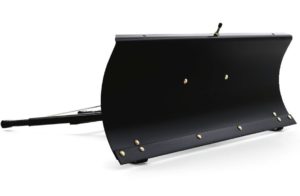
Shovel blade
A standard shovel is 100 cm wide and 40 cm high.
There are two types of motoblock blades, which have some visual differences in their design:
- Shovel blade.
- Ladle.
A shovel-blade for a walk-behind tractor is intended only for cleaning areas from debris, snow, it is used to level crushed stone, soil and sand. The bucket is closed at both ends with welded plates, therefore, in addition to the actions already described, it can also be used to load the very same sand, earth, snow, debris, etc.
We offer you to see a photo where you can see how the shovel differs from the bucket:
Installation type relative to the walk-behind tractor
Due to the relative simplicity of the design, the relatively low weight (up to 16 kg.) And the great functionality of the work performed, the blades can be attached to both medium and heavy walk-behind tractors.
Depending on the design of the walk-behind tractor itself, the canopy can be connected:
- to the front;
- behind the motorized device, taking into account that the steering column of the latter rotates 180 degrees around its axis.
The location of the working body
There are two types of dumps:
- adjustable (rotary);
- unregulated.
Swivel blades are universal, as they allow you to set the required angle of attack:
- right tilt;
- left tilt;
- direct installation.
Non-adjustable awnings are rigidly fixed in the position required by the operator (straight, right, left) and cannot be adjusted.
We offer you to watch a video of the walk-behind tractor using a straight and rotary blade:
Varieties of couplings for walk-behind tractors of famous brands
The hitch is an indispensable device that comes complete with a walk-behind tractor, which allows you to aggregate various attachments. Depending on the brand of the walk-behind tractor, its design, the configuration of the coupler itself also changes. In addition, the couplings are also adjustable (angle of attack, horizontal) and non-adjustable.
There are several types of mounts:

Hitch for KIT-set, equipped with a front lifting mechanism
Hoist types
Lifts allow you to raise and lower the working body (blade for a walk-behind tractor), to carry out loading and cleaning operations. There are several types of lifts:
- manual, or mechanical (lever);
- hydraulic (using a hydraulic pump).
Required materials and tools
Before proceeding with the selection of materials and creating a blade for the MTZ-82 tractor shown in the photo, you should first draw up a plan and drawings that can be easily found on the Internet. To select the optimal dimensions and weight of the equipment, you should take into account what materials you decide to use, as well as the power and weight of the power unit.
To make a snow shovel for the MTZ-82 tractor with your own hands, you need a minimum set of tools, namely:
- measuring instruments;
- hand electric drill;
- welding machine;
- set of drills;
- bolts;
- steel beams or pipes with a diameter of more than 70 mm;
- shock absorbers;
- set of wrenches;
- hydraulic cylinders;
- cutter or scissors for metal;
- Bulgarian;
- steel sheet with a thickness of at least 8 mm;
- rubber strip.
As for materials, the most basic is sheet metal, which will be used for the frame of the unit and directly for the blade itself. Dimensions should be calculated according to the likely maximum loads, or dimensions can be copied from existing factory models.
To make a semi-frame, you will need two thick metal beams, six articulated joints and one hydraulic cylinder. You will also need two pieces of metal pipe of the appropriate size and diameter of the order of 100 mm, and four more swivel joints. But, if a home-made rotary blade is planned, then instead of metal pipes, two more hydraulic cylinders will be needed. This will provide an opportunity to control the rotation of the grader and expand its functionality.
How to make a do-it-yourself blade for a walk-behind tractor
Assembling attachments such as a snow plow is a fairly straightforward task. Nevertheless, in the manufacturing process, you should adhere to a few simple rules.
When choosing or drawing up a drawing of a device, it is important to compare the load on it with the power of the existing walk-behind tractor. The use of equipment, in the design of which too high performance is laid, can lead to overloading of the unit and premature wear of its mechanisms, which leads to its breakdown.
The device to be assembled must meet a number of important criteria:
- Durability. The strength of the knife and bucket must be high enough to ensure that the equipment has a trouble-free service for at least 5 years. All assemblies and components must be assembled from such materials and using such connections so that they can withstand the maximum load.
- Dimensions. There are standard industrial sizes that can vary if made by hand. Nevertheless, one should not go too far beyond the standard framework: it makes sense to make the blade width from 80 to 130 cm, and the height - 30-50 cm.
- It is advisable to provide a lifting mechanism that is easy to implement using levers or hydraulics. Thanks to this, it will be possible not only to clean the snow and remove garbage, but also to take it out of the site.
- The presence of a swivel joint. With the possibility of tilting the knives up and down and left and right, snow removal is better.
- Rubber cushion strip on the bottom of the bucket. This part is needed to protect the unit from impacts, the shovel from breakages and deformations, and the road surface from damage.
- Convenience of quick mounting / dismounting of the hinge plate on the walk-behind tractor.
Before starting production, first of all, it is worth deciding on the size. The standard snow shovel has a width of 100 cm at metal thickness in 2-3 mm. The material for manufacturing should be of high quality.
The first step is to collect the necessary set of tools and materials. You will need:
- welding machine;
- grinder with discs;
- drill with drills for metal;
- spanners;
- pliers;
- steel barrel with a volume of 200 liters or an empty gas cylinder;
- small thick steel sheet;
- a piece of a square pipe 1 m long and a cross section of 40 × 40 mm;
- iron strip - 850 × 100 × 3 mm;
- high strength thick rubber sheet;
- bolts (М12, М10, М8), washers, nuts.
In addition, you need to take care of the drawings - find the desired design on the Internet or draw it yourself, taking into account your own wishes and operating conditions of the unit.
For the manufacture of a bucket, the optimal material is a metal 200-liter barrel, since this container initially has the desired bend.If such a container could not be found, sheet steel of the required thickness will do, but it will have to be heated and bent to the correct radius. If there is a barrel, the first step is to cut off the bottom and the lid with a grinder to make a wide pipe. Next, it needs to be cut from top to bottom into three equal parts. Two of them are welded around the perimeter, and the remaining third is dissolved by a grinder into several strips, the purpose of which will be to ensure the structure of the required rigidity. Two strips are attached to the bottom and top edges of the blade, and the rest are spread over it for reinforcement.
In order to provide the shovel with additional efficiency, a knife is fixed at its bottom. It is made from a metal strip. 3 holes with a diameter of 5-6 mm are drilled in the workpiece, spaced from each other at a distance of 100-120 mm. A rubber gasket is fixed to them, and the knife itself is bolted to the bucket.
This is interesting: disc hiller for the Salute walk-behind tractor.
Having made a shovel, proceed to the assembly of the mount. This part is made from a pipe and is welded to the center of the blade. Next, a semicircle made of thick sheet metal is fixed, in which several holes are made to fix the angle of rotation of the bucket.
After that, an L-shaped holder is made from a pipe segment, which is fixed with the short side in a semicircle, and with the long side is fixed in the frame of the walk-behind tractor. The blade height is adjusted by means of two bolts, which are fixed in an additional piece, also made of a pipe, which is put on the holder.
Making a rotary snow blower for a walk-behind tractor with your own hands
For the independent manufacture of a mounted home-made auger snow blower (auger rotor), you need to think over the placement of the main elements of the equipment, and also tie the dimensions to the existing walk-behind tractor. Therefore, first of all, a layout diagram of the device is created.
Necessary materials
To make a rotary-type snow blower, you need to purchase:
- roofing galvanized sheet, it will be used for the manufacture of screw and rotor bodies, as well as a branch pipe for snow discharge with a deflector;
- an equal-field corner of 40 or 50 mm, it will go to the manufacture of the frame;
- a sheet of steel with a thickness of 2 mm, from which the blades of the auger and rotor will be cut;
- a profile pipe will be needed for the manufacture of brackets;
- bearing housings and the bearings themselves for installing the shaft;
- a pipe or circle with an outer diameter of 30 millimeters or more will be used as shafts;
- pulleys, sprockets and other transmission elements;
- hardware for creating detachable connections.
Making a homemade auger-rotary snow blower
An approximate procedure for manufacturing a mounted auger rotor for snow removal:
- Parts of the auger body are cut out of the roofing sheet. They are bent over a suitable cylinder. The frame of the auger body is welded from a rolled angle or profile pipe. The body and frame are connected into a single unit.
- Auger details. For this, segments are cut out of sheet steel, and then blades are formed from them. The auger shaft must be adjusted to fit the bearings, therefore, on a lathe, the surface is machined to fit the mounting size of the supports, as well as the transmission elements. The blades are welded to the shaft, forming an auger converging towards the center.
- The bearing housings and the bearings themselves are installed. The auger element of the snowblower is being assembled.
- The body of the snow removal rotor is cut from the roofing sheet. Using suitable objects, the final shaping of the rotor housing is carried out.
- Rotor details. The rotor blades are cut from sheet steel. The rotor shaft is adjusted to fit the bearings and transmission elements. Blades are welded to the rotor shaft.
- Balancing is mandatory, since the rotor rotates at a fairly high speed.
- The frame of the rotor body is welded from a corner or a profile pipe.The bearing housings and the bearings themselves are installed. Assembly: the rotor assembly is assembled.
- A homemade frame is made, on which the rotor and auger assembly will be placed.
- The working body of the machine is being assembled. Transmission elements are mounted.
- Brackets for connecting the working body with the walk-behind tractor are fitted.
- Bench tests are carried out, according to the results of which defects and shortcomings are determined. After eliminating the shortcomings, they begin to test the rotary-type snow blower under operating conditions.
It remains to use the manufactured rotary snow blower for the walk-behind tractor for its intended purpose.
Category: Attachments
The final stage
To prevent the device from cutting into the ground, the edge of the blade is sheathed with metal. With the dimensions of the main device - a blade 45 * 22 cm, it will look like a bucket externally.
Take time to check the tension of the V-belt each time you use the machine.
Check and retighten all screw connections at regular intervals.
Timely and consistent performance of such device maintenance will allow your homemade snow blower to operate reliably and efficiently throughout many winter seasons.
Each master is quite capable of making a snow blower for a walk-behind tractor on his own, and experimenting with sizes and materials to learn how to make snow throwers for different models of walk-behind tractors.
To avoid the formation of corrosion on your unit, do not forget to frequently treat metal surfaces with special chemical solutions. Compliance with all of the above recommendations will allow you to avoid costly repairs to the device or the purchase of a new unit.
Find out how to make an electric snow blower yourself - here.
Homemade attachments
The user can make a hitch on the mini tractor with his own hands. To do this, you will need construction drawings, which will indicate the parameters of the equipment being manufactured.
Before proceeding with the assembly of the KUHN, it is necessary to determine the dimensions of the sample and prepare the tools:
- metal profile (the thickness of the metal depends on the type of proposed work);
- 3 hydraulic cylinders;
- articulated joints;
- welding machine and gas cutter;
- wrench and adjustable wrench.
KUHN manufacturing process:
- Cut the inner frame out of two metal sheets.
- Make an arrow, where 70% of the length is the support that will connect to the large cylinder.
- Attach the middle part to the base using hinges.
- Attach a ladle to the middle part (it is made from a prepared metal profile).
Dozer blade
In order to make such a homemade product for a mini tractor with your own hands, prepare the following tools:
- barrel made of steel;
- steel corner 10-15 mm;
- steel square 30 mm;
- 2 hinges;
- 3 hydraulic cylinders;
- fitting;
- hoses;
- transport belt (thickness 20 mm);
- rivets.
- Cut the top off the barrel, then cut it into 3 pieces.
- Bend all edges by 3-5 mm using pliers.
- Make amplifiers from the corner (10-15 mm) and weld the slots. There should be 2 amplifiers at the edges, and the rest should be placed at a distance of 20 cm from each other.
- Weld a square along the entire frame from the bottom and top.
- Weld the braces.
- Install hydraulics between the corner and the square.
- With the help of hinges, hydraulic cylinders and corners, make a lifting and swing system.
The plow is made from a surface in the form of a cylinder (it is recommended to take steel to avoid bending the blade). The workpiece is given the desired shape: it is fed to the rollers at an angle of 20-23 °, bent, and then the work is done with a hammer according to the template.
A hitch is used to attach the hitch to the tractor.
Also, the plow can be made from a steel pipe, the diameter of which is 55-66 cm, and the thickness is 4-5 mm.
A template is made of cardboard, applied to the pipe and chalked around the contour.The dump is cut out using gas welding and treated with emery. If necessary, then finalize the shape with a hammer. Rear hitch is used for attachment to tractor equipment.
Homemade dumps
Now many people prefer to live in their own houses, and accordingly the adjacent territory occupies a large area. To work on a personal plot, motor-cultivators, walk-behind tractors and mini-tractors are purchased.
In winter, snow removal turns into a competition to win who. And owners with motorized equipment prefer to remove snow with its help. Attachments for a walk-behind tractor are not cheap, so craftsmen prefer to make it on their own.
The domestic-made Neva walk-behind tractor is widespread. It has standard attachment points and rubber wheels that are adapted for driving on loose snow. Most of the homemade dumps were made for the Neva.
On the Internet you can find many descriptions and drawings of a shovel for a walk-behind tractor with your own hands. But before manufacturing, you should familiarize yourself with the characteristics of the dumps. Product composition:
- executive (working) body;
- swing mechanism;
- mounting bracket.
Rotation angles:
Turning the shovel to the side allows you to remove the snow mass while driving. Going to the sites for amateur craftsmen, you can find a lot of information on how to make a do-it-yourself blade for a walk-behind tractor.
Blade from a cylinder
One of the materials at hand for making a dump is a gas cylinder. Its height is slightly more than a meter, and the recommended width of the shovel is 1000 mm. Manufacturing works proceed in the following sequence:
- Bleed off excess pressure from the cylinder, if any.
- Cut off both sides of the lid so that the width is equal to one meter.
- Cut the resulting pipe lengthwise into two halves
- Using a welding machine, connect these two halves so that the height of the blade is about 700 mm.
- The mounting bracket is manufactured as follows. Cut a kerchief out of thick metal. Drill several holes in it to turn the shovel in different directions. Weld a piece of pipe to the kerchief.
- Weld the resulting device to the shovel at the height of the bracket on the walk-behind tractor.
- Installation is done with a thick finger.
The thickness of the balloon is sufficient and no reinforcement is required. But the lower part can be equipped with dense rubber, which will remove loose snow and not spoil the compacted road. To do this, you need to take hard rubber from the rotary conveyor.
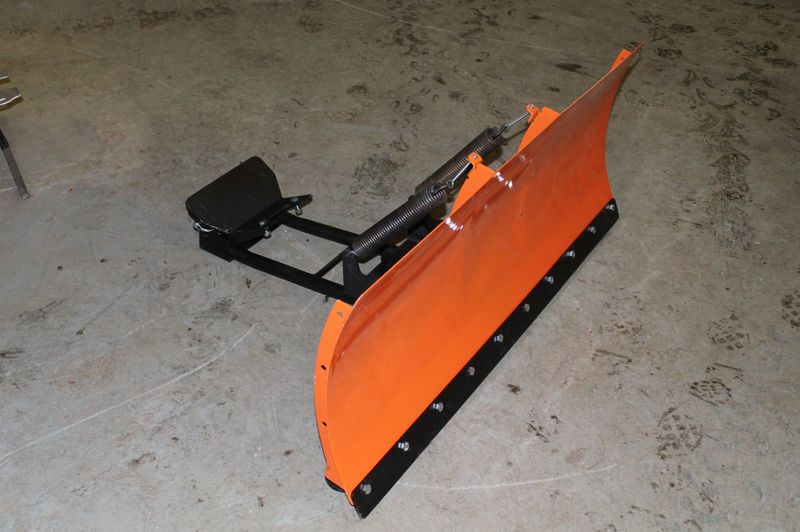
The width of the rubber web is 100-150 mm. Drill holes in the blade with an electric drill to secure the rubber. To securely fix the canvas, a metal strip of 900x100x3 mm is needed. Drill holes in the strip and in the canvas, having previously marked on the blade. Secure with bolts.
Blade made of sheet steel
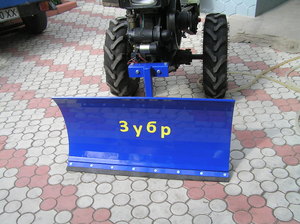 Some craftsmen prefer to use new material, rather than used elements. So you can make a homemade moldboard shovel from steel sheet 3 mm thick. To strengthen the structure, take strip steel with a thickness of at least 5 mm.
Some craftsmen prefer to use new material, rather than used elements. So you can make a homemade moldboard shovel from steel sheet 3 mm thick. To strengthen the structure, take strip steel with a thickness of at least 5 mm.
The material is cut according to the drawings. The blade of the shovel itself has four parts: frontal, lower and two lateral. The welded structure needs reinforcement. For this, elements cut from the five are welded in the vertical direction.
Next, a swivel mechanism is made. It is an ear with a hole for an axle. The ear is welded to the corner, which is attached to the blade. The axis is fixed at one end of the pipe, and with the other end it is fixed on the walk-behind tractor. The required angle of rotation is fixed with a pin (dowel).
3 mm - the thickness is small, therefore reinforcement is required. Cut a strip 850x100x3 from 3 mm sheet. You can fix it with a bolted connection, but you will first have to drill or weld the strip.
As you can see, to carry out the work you will need:
- working material;
- grinder with discs;
- electric drill with drills;
- bolts with nuts;
- welding machine with electrodes;
- spanners;
- round or shaped pipe.
If you have certain skills, the job is straightforward. And the resulting structure can be used not only in winter, but also in summer. Level the site after construction works, level the area for the children's sandbox and much more. Which design to choose is up to you.
Blade from a gas cylinder - how to do it yourself?

One of the most common options is to make a blade from a 200 liter barrel or from a gas cylinder. Such a nozzle for snow removal will successfully cope with the clearing of the local area from the caked ice-covered snow masses, and will save you time and effort. As in the first case, you will need a detailed diagram, which will describe in detail all the dimensions and installation location of the main elements of the snow blower.

Further, to make an auger or rotary snow blower, you will need to prepare the same materials and tools as in the first case. Steel sheets and stiffeners do not have to be purchased - a cylinder or barrel will be used instead.
A snow plow for a walk-behind tractor is made as follows:
- Cut an empty barrel or cylinder into 3 parts - as a result, you should have 3 curved segments, from which you need to make a shovel;
- Weld 2 segments from the resulting three to each other along the contour. As a result, you will receive a product with a thickness of 3 mm - this is quite enough for high-quality snow removal;
- Install a sturdy steel blade to reinforce the bottom of the blade. Drill 3 holes in the knife with a pitch of 10 and a diameter of 6 mm. When installing the knife on the bucket, place a rubber gasket between the elements;
- Weld a semicircle in the middle of the installed pipe, in which 3 holes have been made in advance - they will be used to securely fix the pivoting corners of the bucket;
- From another piece of pipe, make an L-shaped holder. Insert one of the ends of the part into one of the holes in the semicircle, and fix the other on the frame of the walk-behind tractor. You can see the result of the work done in the photo.
A ready-made snow shovel will help remove a large amount of freshly fallen and packed snow. Thanks to the wide bucket width, you can clear a significant swath, saving you time and effort. For better cleaning of the local area, a sweeping brush can be installed on the manufactured dump. It should be bolted just behind the bucket. If you want to use this element, then during the manufacture of the blade, 2 pipes must be welded to its side parts, at least 1 m long. A third pipe is welded perpendicularly to the pipes, and the brush itself is welded to it.
How to create a snow plow from a barrel?
Making a shovel on your own is easy when you have a welding machine, a grinder and an electric drill in your house. Here's one easy way. You do not need to search for the necessary material, since you can use a simple 200-liter iron barrel.
Carefully cut it into 3 slices and you will have 3 curved pieces for the snow plow. Welding 2 of them along the contour line, we get an element with an iron thickness of 3 mm, which is fully enough for the rigidity of the shovel
The lower segment of the shovel is reinforced with a knife. This will require a metal strip 5 mm thick and the same length as the blade grip. Holes are made in the knife with a caliber of 5-6 mm with an interval of 10-12 cm for mounting a protective rubber strip.
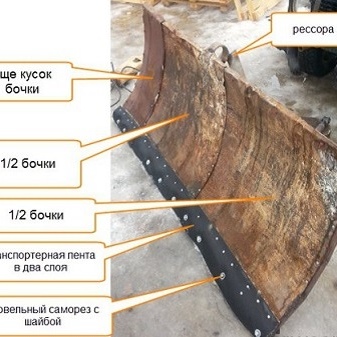
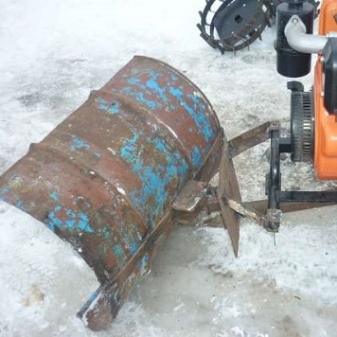
The mechanism for attaching the shovel to the cultivator is quite simple and can be done at home. A pipe with a cross-section in the form of a square 40x40 millimeters in size is cooked to a shovel, assembled from two parts of a barrel, approximately in the middle of its height for reinforcement.Then, in the middle of the pipe, a semicircle of thick iron is cooked, in which 3 holes are pre-made, required to stabilize the angles of rotation of the moldboard shovel.
Next, a bracket that looks like the letter "G" is welded from the same tube, one edge of which is placed in a hole in a semicircle, and the other is connected to the chassis of the unit by means of bolts.

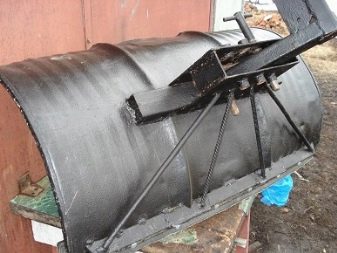
Factory models
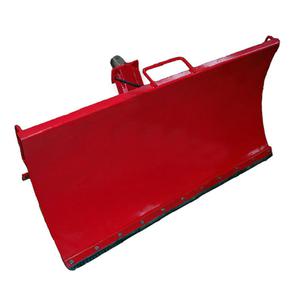 Any company that manufactures motoblocks can also offer a range of snow plows. There are popular models of such manufacturers as Centaur, Neva, Zirka, etc. on sale. The only big advantage of a factory design over a self-made one is that they are made of high-quality steel and are more difficult to damage. Moreover, such models last longer than homemade ones. But, on the other hand, they cost a lot.
Any company that manufactures motoblocks can also offer a range of snow plows. There are popular models of such manufacturers as Centaur, Neva, Zirka, etc. on sale. The only big advantage of a factory design over a self-made one is that they are made of high-quality steel and are more difficult to damage. Moreover, such models last longer than homemade ones. But, on the other hand, they cost a lot.
There are a lot of options for factory dumps, so you should check before buying whether this model is suitable for your existing walk-behind tractor. At the factory, snow plows are not equipped with spring mechanisms due to the low speed of movement. If the speed of the walk-behind tractor is small, then the protective mechanisms for contact with the ground lose their meaning. Moreover, in the factory models there are no mechanisms for lifting and turning the unit. In this regard, the price of the factory design is reduced.
For higher performance, it is recommended to replace conventional rubber wheels with factory or homemade lugs. This will speed up the work process.
Snowplow prices vary. Basically, the cost of such varies from 4 thousand to 6 thousand rubles.
Snow blower device
The mounted auger snow blower has a metal body with a shaft inside. On the shaft there are auger blades made of steel sheet of complex shape. The shaft is mounted in bearings, which allows it to rotate.
The rotor is visible inside. A swivel pipe is located above the rotor. It can be deployed in any direction. There is a hitch for mounting the auger snow blower, inside which the power take-off shaft (PTO) of the walk-behind tractor is located.
The torque is transferred to the actuators. When the auger shaft rotates and moves forward, the snow is captured by the blades and moves from the periphery to its center. The snow mass, moving along the augers, collapses, its structure changes, so it will be easy to throw it aside.
From the auger pick-up mechanism, snow flows onto the rotor blades. Here, its translational movement is converted into rotational movement. It receives tangential acceleration and is thrown through the nozzle in a given direction: to the right or to the left in the direction of the snow blower. Here the operator guides the deflector so that the removed snow does not interfere with the work.

